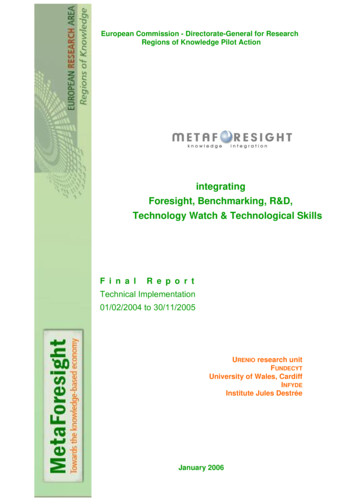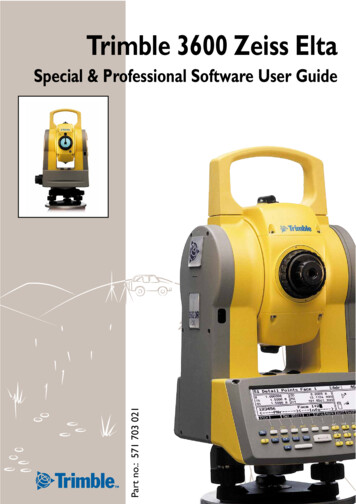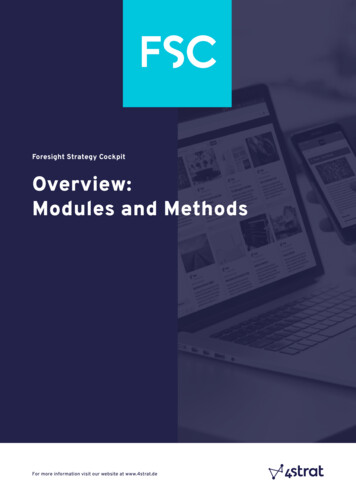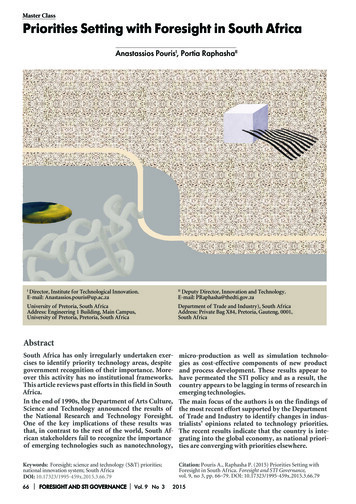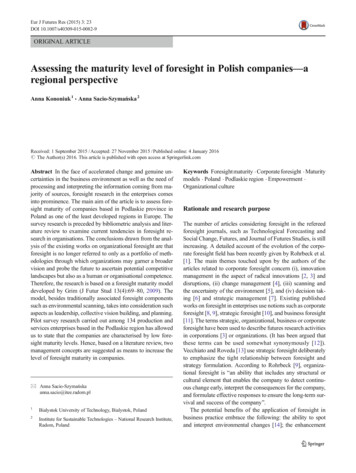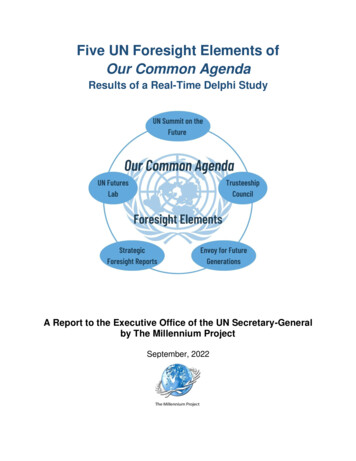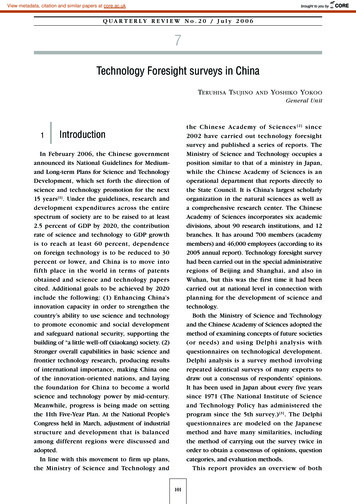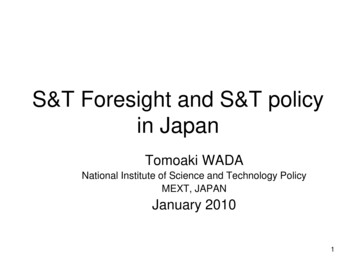
Transcription
S&T Foresight and S&T policyin JapanTomoaki WADANational Institute of Science and Technology PolicyMEXT, JAPANJanuary 20101
Contents1. Science and Technology Foresight2. Science and Technology Policy Basic Research Green Innovation Fostering S&T Human Resources2
MegatrendsJapan as a highly aged societyNow128 million・Population・Elder/Young2025121 million1/41/2※Elder: aged over 65, Young: aged 15-64(Unit: 10,000)Source: National Institute of Population and Social SecurityResearchYear-to-Year Change in Japan’s Population14,00012,00065 2000, 127.77million10,0008,0006,0004,0001967, 100.24 million(Exceeded 100 millionfor the first time)1920, 55.96 million (firstpopulation census conducted)Actualfigures15 to 642008, 127.57 millionEstimatedfigures2055, 89.99 million2,0000 to 140(Year)1920 1930 1940 1947 1950 1955 1960 1965 1970 1975 1980 1985 1990 1995 2000 2005 2010 2015 2020 2025 2030 2035 2040 2045 2050 20553
Science and Technology Basic Plan HistoryMarch 1994S&T Committee of LDP starteddiscussionsOct 19954 Parties jointly submitted thebill to the Diet.Nov 1995S&T Basic Law was approvedby the Diet. Content(1) Guidelines for promotion ofS&T(2) Responsibilities ofGovernment andMunicipalities(3) Establishing S&T Basic Planand preparing necessaryfund to promote it(4) Measures to be implementedby the government, includingfostering S&T personnel andconstruction of researchfacilities4
S&T Administrative Strructure in Japan- 20002001 PrioritizationSTCCoordinationCSTPTop downBottom upBottom nistriesPlanningImplementation5
Development of National Foresight in JapanForesightDevelopment of S&T Policy1971 The 1st Technology ForesightDelphi1970-80s 1977 The 2nd Technology ctorConsensus among sectorDelphi1982 The 3rd Technology ForesightDelphi1987 The 4th Technology ForesightDelphiTransitionphasephase1990s Transition ModeratelinkModerate linkbetweenbetweenS&TS&Tpolicyandforesightpolicy and foresight1995S&T Basic Law1996-2000stThe 1 S&T Basic Plan1992 The 5th Technology ForesightDelphi1997 The 6th Technology ForesightDelphiCentral Government Reform 2000- e2005 The 8th fofforesightforesight?2006 - 2010S&T Basic Plan3rdInnovation 25Political Shift 2001 The 7th Technology ForesightDelphiThe2010-2001-2005S&T Basic Plan2nd?Multi-methodologyWith Review Program2009 The 9th Foresight?6
History of Japanese Delphi SurveyNO.Survey 1996141072358672000161065310682004138582239Delphi, Scenario,Bibliometrics,Needs analysisExperts Respondents (2 cycles of the questionnaires)7
Evaluation of Early Survey at 20044th Delphi (1986)8
Design of the 8th foresight programMulti - methodology ForesightImproved Delphi and Complementary three othersImprovementwith new approachesObjectiveExtrapolativeDatabase analysisto find rapidlydeveloping areasBibliometricAnalysisNeeds list throughparticipatory processDelphi SurveyScenario writingin individual cenario AnalysisScience(Basic ) Not only Technology, but also Science and Social needs Wider variety of participants9
What is Delphi?:“Converged Opinions by Experts” The name “Delphi” is taken from the location of theTemple of Apollo in ancient Greece, where the godswere said to visit the Oracle in order to have their futurestold Originally developed by RAND corporation, USA inthe1950s Intuitive (qualitative) and quantitative: opinion survey to alarge number of experts repeated at least twice Encouraged exchange of opinions among expertstoward convergence Useful for long-term foresight where opinions of expertsare only source available10
What is Delphi?: convergence Repeated the same set of questions to thesame group of experts– At the second round or later Feedback from previous round Chance for respondents to re-think their judgments Some respondents change their judgments,seeing how far their opinions correspond withothers’.11
Overview of the 8th Delphi SurveySurvey 13 fields including 130 areas and 858 topics Information and Environmentcommunications Nanotechnology and Electronicsmaterials Life sciences Manufacturing Health, medical care Industrial infrastructureand welfare Social infrastructure Agriculture, forestry,fisheries and food Science and technologyfor society Space, marine andField: Informationand communicationsearth sciences Energy and resourcesArea: Ubiquitous networkingTopics: An administration system for networks with about 1,000 users thatcan automatically connect terminals and operate networks with no needfor a network administrator.12
Survey Flow Chart13
Example in new Delphi 時期のギャップTime lag to Social realization15Time lag to Social realizationGap (yrs) InnovationGap (years)Environmental and ecological biologyRegenerative medical scienceNano devices and sensorsClean-use technology forfossil resourcesInnovative nuclear power systems10NEMS technologyBasic technologyfor manned spaceactivity502005201020152020New information andcommunications principlesinformatio/communicationselectornicslife sciencehealth/medical ce/marine/earht lsManufacturingIndustrial infrastructureSocial infrastructureS&T for society2025Time of Technological Realization (yr)Time of technological realizaiton (year)203014
Emerging Technology in “Information & Communications”“Important topics” Top 10TopicAreaYearA highly reliable network system capable of protecting the privacy and secrecy of individuals andgroups from intrusion by malicious hackers.Information security2012/ 2016Generalized technology, extended from total building management systems and home securitysystems, which is coupled with seismic detection systems so that the safety of human life can beensured before seismic waves arrive, in an earthquake whose epicenter is distant.Information security2012/ 2020Technology to detect intrusions and viruses on the Internet backbone.Information security2009/ 2013Capability of tracing back the source address of suspect packet in the Internet to detect intrusions.Information security2009/ 2013Forecasts of diseases and disasters through advanced modeling and simulation technologies forlarge-scale ecological, environmental, or other systems.High-productivitycomputing2015/ 2023Theory for designing the stringency of a system's security and privacy protectionInformation security2012/ 2018In Japan, all patient charts, including relevant video, are digitized and maintained by individualpatients, and inspection and other data are shared among all medical institutions, leading to theemergence of health care agents, who intermediate between patients and medical institutions.Information technologyfor developing socialsystems/ 2016Telemedicine in which a doctor performs diagnosis over the Internet based on the patient's medicaldata obtained at home, and provides treatment if standard instruction and prescription areapplicable.Information technologyfor developing socialsystems/ 2015A global traceability system that covers a majority of foods.Information technologyfor developing socialsystems2011/ 2019The emergence of equipment, including a software modem, that supports almost all media such asdigital broadcasting, high-speed mobile communications, wireless LANs, and wired access leads tothe widespread use of cross-media services, which allow for concurrent access to multiple mediaand automatically choose the optimum medium for the situation, to control and coordinate homegateways in households.Very large scaleinformation processing2011/ 2015: Information Security: IT for Social System: High-productivity computing15
Example : Technology trajectoryArea: Ubiquitous networking2005 2010 2015 2020 2025 2030 2035A system to allow ad hoc communication between wirelessinformation terminals within a certain rangeCommunication An administration system for networks with about 1,000users that can automatically connect terminals and operateand networknetworks with no need for a network administrator.technologyTechnology that allows objects to recognize mutualpresence, nature, and condition so that they canautomatically avoid dangerous situations and work in acoordinatedmanner.A micro communicationschip or sensor that can run semipermanently, powered by heat, light, radio waves, or n tomedical careTechnology to manage ID of an infinite number ofconstantly emerging or disappearing objects, organize thedefinition and information of each ID assigned, andautomatically remove obsolete data.Technology to allow many small single-function robots tocooperate and share tasks to achieve more complexfunctionality.A medical chip that can be embedded in the human bodyand run semi-permanently powered by bioenergy sourcessuch as body heat or blood flow, providing vital functionsupport such as health condition monitoring and heartpacemakers.Medical technology based on nanochips and microsensorsthat have external communications and control capabilitiesand can be embedded in the human body or move throughblood vessels.16
Index in Increased intellectual assetsChange in Impact Indexin “Electronics”beyond 2015until 2015BioelectronicsSilicon electronicsOptical andphotonic devicesIntegrated systemsStorageMolecular andorganic electronicsRobotEnergy conversion/electronics storage devicesWireless electronicsUbiquitouselectronics Digital home appliancesNetworkDisplayselectronicsCar electronicsSecurity electronics17Index in Economic & Social impacts
Scenario Analysis written by experts with deep insight. normative and subjective. schematic future image with time scale.Themes:Analyze the present state47 themesWriters:Write a scenario2 experts selected by conomination to each themeScenarios:Actions (Strategy & tactics)85 scenarios Examples Progress of studies in mathematics and mathematical educationNew healthcare that meets individual needsLife support roboticsMaterials design through computer simulationDr. Peter FRANKLDr. Heisuke HIRONAKADr. Ken-ichi ARAIDr. Hiroshi TANAKADr. Kazuhiro KOSUGEDr. Norihiro HAGITADr. Masao DOIDr. Akira MIYAMOTO18
Example of ScenariosTheme 20: Life support roboticsDr. Norihiro Hagita, Intelligent Robotics and Communication Laboratories,Advanced Telecommunications Research Institute International Development scenario The development of lifestyle support robotics will be atStage 1 from now until about 2015, with technology for“mechanical robots” and “communications robots”developing separately. Beginning about 2016, Stage 2 willlikely see the development of integrated technology.Development during Stage 1 is likely to progress asfollows.Stage 1(Now through 2015)Stage 2(2016–2030)Mechanical robotsSingle-function household robots Upgrading of functions through networks Coordinated service by networked ions Japan should take StrategyCommunications robots1: Connecting various robots to network information and communications infrastructure is the toppriority. Strategy2: Power-assist technology should be given priority for advancement. Strategy3:Take initiatives on social intelligence (communication with human beings) rather than onindividual intelligence. Inparticular, Japan should establish initiatives to actively advance collaborative research in social science,19cognitive science, brain science, and other research fields related to robot-human interaction (research onsocial intelligence-utilizing robots)
Contribution of the 8th Foresight resultsto the discussion for The 3rd Basic PlanTotal impacts of 8 prioritized fields*1: Impacts of each field are evaluated by average of areas which belong to the interested field.*2: Radius of each circle shows the number of areas with top 1/3 total impacts in each field8.5Medium term(2015-2025)Delphi Survey8.01. Enhancement of intellectual assetsa: Contribution to enhancing intellectual assetsin the interested area itselfb: Contribution to progress of other areas7.5c: Contribution to development in existingindustriesd: Contribution to creating new industries andbusinesses3. Social effectse: Contribution to securing safety and securityf: Contribution to improving quality of life andsocial vitalityMeasure for evaluation: Large (10), Largish (7.5),Moderate (5), Small (2.5), None (0)S&T Impact2. Economic effects7.06.5Life sciences6.0Information and telecommunicationsThe environmental sciencesCurrent time5.5Nanotechnology & materials science/technologyEnergy(-2015)Manufacturing technologyInfrastructureFrontier -outer space and the oceansOthers5.05.05.56.06.57.0Socio-economic Impact7.58.020
Example Image of Future societyin a view of “Disaster prevention and safety”( year ) : Social realization timein Delphi resultsA wide-area disastermonitoring and safeevacuation guidance(2018)Automotive system(2016)Disasterrescue robot(2020)High-accuracyrainfall prediction(2019)System to preventroad accidents(2018)Prediction ofbig earthquakesin 5-10 ys (2021)Detection of dangerin public space(2020)Food traceability(2019)A miniature analysisas on-the-spot checking(2019)21A highly reliable network(2016)
Development for new approach in methodologyFinland – Japan Collaborative ResearchHistory in foresight activitiesFinland Embedded technology foresights in mid-term evaluationlinking with Finnish Innovation policy Success of FinSight 2015 (2006)- Impact on Finnish business/industry and societyJapan 40 years history of foresight activities Periodical survey- Improved Delphi survey, - widely coverage of S&T fields, - participation of many experts Stronger linkage with policy making process after 2000 Multi-methodology type of foresight at the last(8th) (2003-04)22 Exchange of different type of experiences
Finland – Japan Collaborative Research (2007-08)Organizers: Tekes (Finland), NISTEP (Japan)Trial for new type of foresightintegrating some methodsSelection three themesat each countryTheme ATheme BTheme CPanel discussionPanel discussionPanel discussionMini size DelphiScenarioby individualScenarioby individualWorkshopWorkshopScenarioby individualTheme A :Healthcare and wellbeing to preparefor aged societyTheme B :Consumers, media and digital convergenceTheme C :Recycling society for sustainable environmentWorkshopSummarizedas each reportComparison of two countries at WorkshopJoint Report (Summary)Similar imagefor the future23
First stage for the 9th foresightCoupling and mixing of two types of interdisciplinary subcommitteesextending beyond existing fieldsDiscussion by 4 Targets 12 Interdisciplinary SubcommitteesInterdisciplinary discussionincluding members ofhumanities and social sciencesDiscussion by targetCross-field discussion of science and technologyInterdisciplinary discussionacross the ompetitiontopics RegionDiscussion for grand challengesin Japan and in other developed countriesSecond stage24Delphi survey, Scenario writing etc. in 2009
Foresight Japan has continued foresight program for around 40 years.The basic concept has been “ important S&T issues in the next 30years” and “society derived from their benefits”. NISTEP has tried to foresee what the next should be. We arenow discussing about direction in innovation policy and S&T policyin the world and about key points for the next S&T Basic Policy inJapan.25
Aiming to be an advanced scienceand technology-oriented nationScience and Technology Basic Law(enacted in 1995) Review of the 1st and 2nd plans Increase ingovernmentalR&D expenditureThe total budget forgovernmental R&Dexpenditure exceeded 17trillion yen. Construction of newR&D system・Increase in competitiveresearch funds・Support plan for 10,000post-doctoral fellows(including Ph.D students)・Promotion of ntation of evaluationsystemsetc. Three basic ideas(1)The 1st and 2nd S&T Basic Plans have(i) Creation of wisdomsolidified the foundation of S&T in Japan.(ii) Vitality from wisdom(2)“Mega-competition for knowledge” that(iii)Sophisticated society byJapan faces involves not only the UnitedwisdomStates and Europe but also Asian Key policiesnations such as Korea and China.・Strategic priority setting in S&TOur decision for future:-Promotion of basicstronger emphasis on the role ofresearches“Wisdom”-Prioritization of R&D onnational/social subjects Highlight・S&T system reforms-Doubling of competitive How to nurture creative S&T personnel?research funds Further reform of S&T systems, leading to-Enhancement of industryhigher performance irrespective of Japaneseacademia-governmentserious situation due to limited resourcescollaboration・Total budget :24 trillion yenInvestment under the Basic Plan26・30 Nobel laureates within 50Approx. 25 trillion yen 26years
27
Prime MinisterDr. Yukio HATOYAMA Doctor of EngineeringMr. Hirofumi HIRANOChief Cabinet Secretary Bachelor ofEngineeringMr. Naoto KANDeputy Prime MinisterMinister of FinanceMinister of State for Economic and Fiscal Policy Bachelor of ScienceMr. Tatsuo KAWABATAMinister of Education, Culture,Sports, Science and Technology Master of 28Minister of State for Science and Technology Policy Engineering
Discussion between PM Hatoyama andNobel Prize Winners ( Nov. 2009)Nobel Prize Laureates;“What matters in science is generating new ideasmaking all-out efforts to come out on top in a certainfield.”“If we are satisfied with second place, we can end up30th place. If we only copy, it means we do nothing.”29
Science and Technologyin Basic Policy of “New Growth Strategy”by the Government (Dec.2009)( Major Items) Basic research and new frontier research Independent research environments and various career paths foryoung researchers Outstanding environment in terms of research fund, researchsupport and life conditions to attract researchers all over the world. Government-Industry collaboration and venture business creation Increasing Japan total R&D investment to more than 4% of GDP by2020 Green innovation in environment/energy area Life innovation in medical and nursing-care area Increasing the number of universities and laboratories at the worldtop level and aiming to achieve full employment of the doctoralcourse graduates in science and engineering fields by 202030
The science and technology-related budget allocation policy for FY2010New resource allocation policyPrime policy issue: promoting green innovation to strike a balance between environment and economy,and to achieve “the reduction of CO2 emission by 25 % by 2020 comparing with the level of 1990 if all majoreconomies agree on ambitious targets”1)Diffusing highly-energy-effective technology worldwide2)Accelerating innovation in R&D in solar cell and so forth3)Inventing breakthrough technology by discovery and integration of new S&T findingsPrioritized missions: promoting S&T measures to pursue the followings;1)Health and longevity society2)Regional S&T measures3)Pioneering Projects for Accelerating Social Return4)Innovation5)Science and Technology DiplomacyChallenges to support prime policy issue and prioritized missions :1)Reinforcement of basic research2)Reinforcement of human resources development3)Reinforcement of production and security of intellectual property31
Trend of Japanese S&T BudgetGovt. S&T Budgets have been leveling off(100 mil50,00046,414(3rd supplementary budget)45,00041,636(2nd supplementary 53611,314(initial budget)35,00040,76637,605(1st supplementary 535,44435,70835,44435,72331,56723,5855,0000FY1991 FY1992 FY1993FY1994 FY1995 FY1996 FY1997 FY1998 FY1999 FY2000 FY2001 FY2002 FY2003 FY2004Before Basic Plan12.6 tril yen1st Basic Plan17.6 tril yenFY20052nd Basic PlanFY2006 FY2007 FY2008 FY2009 FY20103rd Basic Plan18.8 tril yen2nd Basic Plan (include local budgets)accumulated amount24tril yen21.1tril yen25tril yen32
R&D Expenditure in Japan in 2006R&D Expenditure in 2006X 0.1 Billion ResearchAppliedResearchDevelopment33
Construction of Research Areas using database of scientific papers(Science Map 2006)Purpose: To ascertain the evolving nature of scienceMethod: Clustering scientific papers using co-citation relationand analyzing those correlations, based on a database comprising scientific papers.Applications:・ Identify “hot” research areas in science・ Tracking the changing nature of research areasBasic and applicationresearch on carbonnanotubesResearch Areas Selected Research Areas (124)Other Research Areas (563)研究領域(687)Researchareas(687)Object for content ��よる第二段階クラスタリンusing co-citation relationshipCNTs synthesismethodsHydrogenabsorptionto 538)Research FrontsMechanicalcharacteristicof CNTs1st clustering1st clustering using co-citation 約5万1千件)34
Science Map 2006Depicting the scientific activity of JapanShare of papersGhrelin / function andpathophysiological significance(ID15, 34%)0.30OrmoreConstruction ofartificial photosynthesismodel mimickingantenna system andcharge separationsystem (ID80, 80%)Innate immunity (ID108,38%)Superconductiveproperties ofmagnesium diboride andits application (ID53,27%)High-temperaturesuperconductivity spectroscopy /new electron phase (ID58, 44%)Brane cosmology from the perspective ofduality of anti de sitter space and conformalfield theory (ID65, 35%)Note: Whole count method is applied for calculation of paper share. Blue indicates 5% of paper share, and red means more than 30% of paper share.Source: Compiled by NISTEP based on “Essential Science Indicators” published by Thomson Scientific.35
The 2008 Nobel Prize in Physics and ChemistryScience Map 2004 (1999-2004)Science Map 2002 (1997-2002)ID79 Supersymmetry and CP violationID106 Molecular imaging using GFPResearches using GFP833Muon anomalous magnetic moment5850Dark matter5211CP violationin K ymmetry theory117588815033562142835523457Higgs boson P violation in B meson1541Researches using GFP1126039Researches using GFP Each circle: Single RF– Red circles: Hot RFs– Yellow circles: New RFs (emerged in 2002)– Radius: Number of citing papers The relative locations of circles reflect how strongly they are linked to one another (Only the strongest areshown)36
B FactoryPositronelectronelectronElectron/ PositronbypassB Factory is an electron-positron collider.The KEK B factory experiment (Belle) wasinitiated in 1999. Using a large datasample that corresponds to anintegrated luminosity of 0.8 ab ¹ or 900million B anti-B meson pairs, which isthe highest value in the world, the Belleexperiment has verified the Kobayashi Maskawa theory that explains CPviolation and quark mixing in the weakinteraction. This research eventually led toa Nobel prize for Kobayashi and Maskawa in2008.Electron/Positron Linac37
J-PARC ProjectBudget in FY2009: 15,220MYenJ-PARC :Japan Proton Accelerator Research Complexaccelerated proton muonpionE -neutrinokaon target(metal such as mercury) neutronHadron Facility (KEK)anti-proton J-PARC is one of the world largest accelerator-drivensecondary particle sources (neutron, muon, pion, kaon,neutrino, etc.), providing a broad base for research anddevelopment from basic science to industrial development. J-PARC is a joint project between Japan Atomic EnergyAgency (JAEA) and High Energy Accelerator ResearchOrganization (KEK).50-GeV Synchrotron (KEK)Materials and LifeScience Facility (MLF)(JAEA)Chronology of J-PARC Construction start in 2001 Neutron production at MLF in May A) Muon production at MLF in September2008 Completion of J-PARC construction atend of 2008 Experiment at the hadron facility in 2009.LINAC(JAEA)J-PARC is located in Tokai-mura, Ibaraki-ken,(120km North East from Tokyo) Experiment at the neutrinos facility in2009.38
Science Program of the J-PARCMaterials and LifeScienceNeutrons andmuons are goodprobes for revealingthe functions ofmaterial structureExample of Li-butteryLiOMnOLiX-RayNeutronJ-PARC offers the world’s highestpulsed neutrons and muons.Neutrons are also a goodprobe for life sciences, fordeveloping new medicines andconquering intractablediseases.Li-battery, hydrogenabsorbing materials,new have revealed anew aspect ofsuper-conductor(CaFeCoAsF)!Superconducting phase (Island)Biologicalstructure analysisapparatusMagneticphaseHadronphysicsNeutron andMuonJ-PARCNeutrinoKaon, Pion,Proton,MuonOrigin of MatterNeutrino Experiment: T2KDiscover unknown properties of neutrinos by precisemeasurement of “neutrino oscillation” and find clues to: Fundamental law of elementary particles Origin of Kamioka neutrino-------------- to -------------neutrino TokaiPrimary goal is to discover μ neutrino to electron neutrino oscillation・ Mystery of the origin of massWhy do hadrons have much greater massthan free quarks?・ Particle/anti-particle asymmetry beyondKobayashi-Maskawa TheoryAsymmetries in quark and lepton sectors39
World Premier International Research Center (WPI) InitiativeImplementing World Premier International Research CenterBackgroundIn order to enhance the level of science and technology in Japan and continuously trigger innovation that serves aa catalyst for future growth, it is necessary to boost the nation’s basic research capabilities. To this end, Japan neto create centers where the world’s finest minds meet and superb human resources flourish, thereby generatingoutstanding research results.OutlinesAimed at establishing “ globally visible research centers” with excellent research environment that attract the world’stop researchers. TopicsInterdisciplinary field of basic research 5 centers were selected in FY2007Period: 10 15 years(evaluated every 5 yrs)Funds: Y500 mil -2 bil, average 1.4 bil yen Attractive research environment of top internationalstandard・Director with strong leadership・Rigorous evaluation system & rewards based on theevaluation results・English as the primary language for work Excellent research level・Establish critical mass of outstanding researchersKyoto UniversityInstitute for Integrated CellMaterial Sciences (iCeMS)Tohoku UniversityAdvanced Institute for MaterialsResearch (AIMR)NIMSInternational Center for MaterialsNanoarchitectonics (MANA)Tokyo UniversityThe Institute for thePhysics andMathematics of theUniverse (IPMU)Osaka UniversityImmunology Frontier ResearchCenter (IFReC)40
Japan’s stance for COP15 Japan aims to reduce its CO2 emissions by 25%by 2020 from the 1990 level. Japan would provide assistance to developingcountries worth approx. 15 billion US dollars intotal up to 2012, including 11 billion in publicfinancing. These are premised upon the establishment of afair and effective international framework by allmajor economies and agreement on ambitioustargets.41
Expanding Advanced Technologiesto Reduce Global Emissions42
Overview of Measures for Green InnovationAccelerating innovation in R&Din solar cells, etc.R&D for new energy technology(developing next-generation high efficiency photovoltaicgeneration system)(Ministry of Economy, Trade and Industry: METI)c-Si solar cellSilicon thinFilm cellDiffusing highly energy-efficienttechnology worldwideUS-Japan cooperation on energy andenvironmental technology research andstandardization (METI)- Reducing CO2 by establishing and diffusing ofenergy and environmental technologies based onUS-Japan collaborative research andstandardization planCopper-Indiumselenide solar cellCompound electricity storage system technology (METI)- Developing efficient and effective storage systems forexpansion of photovoltaic generation’sInventing breakthrough technology bydiscovery and integration of new S&TfindingsDeveloping advanced low-carbon technology(MEXT)- Promoting new technology and establishment ofprinciples that contribute to GHG reduction, andaiming at breakthroughs by integration of S&T43findings
Green InnovationGreen InnovationEnvironment &Energy TechnologyInnovation Diffusion of practical technologies R&D for innovative and state-ofthe-art technologies Aid for developing countries(Hatoyama Initiative)Social Innovation Lifestyle“Mottainai” Revitalizing forestry and agriculture Creating green industry44
How is the Score ?! (PISA and TIMSS)PISA (surveyed by OECD)Average score Japan ‘00‘06‘03Mathematical literacy1st/32countries 6th/41countries,areas 10th/57countries,areasScientific literacy2nd/32countrie ‥Programme for International Student Assessment※surveyed object : Tenth gradersTIMSS(surveyed by IEA)Results of Arithmetic / Mathematics and sciences Japan tries4rd/37countriesMathematic in junior 2nd/26countries rd5 /46countries 5rd/50countrieshigh school‘95‘03
1982 The 3rd Technology Foresight 1987 The 4th Technology Foresight 1992 The 5th Technology Foresight 1997 The 6th Technology Foresight 2001 The 7th Technology Foresight 2005 The 8th Foresight Delphi Multi-methodology S&T Basic Law The 1st S&T Basic Plan The 2nd S&T Basic Plan The 3rd S&T Basic Plan 1995 1996-2000 2001-2005 2006 - 2010 .

